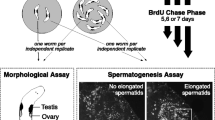Abstract
When male and hermaphroditeCaenorhabditis elegans mate, the male's sperm outcompete the hermaphrodite's own sperm and fertilize a majority of the offspring. Here, we investigate the mechanism of male sperm precedence. We rule out the possibility that male sperm are stronger and more competitive because they are activated later than hermaphrodite sperm. We also find that a previously known gender difference in sperm activation does not influence sperm competition. Male sperm, rinsed free of seminal fluid, retained the capacity to take precedence after artificial insemination. Therefore, we conclude that male sperm themselves are competitively superior to hermaphrodite sperm. This trait maximizes outcrossing after mating and may increase both genetic diversity and heterozygosity of offspring whose parents, due to self-fertilization, may be highly homozygous.
Similar content being viewed by others
References
Barker, D. M., Anim. Behav.48 (1994) 147.
Van Voorhies, W. A., Nature360 (1992) 456.
Shakes, D. C., and Ward, S., Devl Biol.134 (1989) 189.
Ward, S., and Carrel, J. S., Devl Biol.73 (1979) 304.
Waller, D. M., in: The Natural History of Inbreeding and Outbreeding, p. 97. Ed. N. W. Thornhill. University of Chicago Press, Chicago 1993.
Honda, H., J. morph. Physiol.40 (1925) 191.
Argon, Y., and Ward, S., Genetics96 (1980) 413.
Brenner, S., Genetics77 (1974) 71.
LaMunyon, C. W., and Ward, S., Genetics138 (1994) 689.
Nelson, G. A., and Ward, S., Cell.19 (1980) 457.
Klass, M. R., and Hirsh, D., Devl Biol.84 (1981) 299.
Silberglied, R. E., Shepherd, J. G., and Dickinson, J. L., Am. Nat.123 (1984) 255.
Dickinson, J. L., Behav. Ecol. Sociobiol.18 (1986) 331.
Simmons, L. W., and Parker, G. A., Evolution46 (1992) 366.
von Helverson, D., and von Helverson, O., Behav. ecol. Sociobiol.28 (1991) 391.
Waage, J. K., Science203 (1979) 916.
Walker, W. F., Am. Nat.115 (1980) 780.
LaMunyon, C. W., and Eisner, T., Proc. natl Acad. Sci. USA91 (1994) 7081.
LaMunyon, C. W., and Eisner, T., Proc. natl Acad. Sci. USA90 (1993) 4689.
Dewsbury, D. A., in: Sperm Competition and the Evolution of Animal Mating Systems, p. 547 Ed. R. L. Smith. Academic, Orlando, Florida (USA) 1984.
O'Brien, S. J., Roelke, M. E., Marker, L., Newman, A., Winkler, C. A., Meltzer, D., Colly, L., Evermann, J. F., Bush, M., and Wildt, D. E., Science227 (1985) 1428.
Maynard Smith, J., in: Group Selection, p. 163. Ed. G. C. Williams. Aldine-Atherton, Chicago, Illinois (USA) 1971.
Bernstein, H., Hopf, F. A., and Michod, R. E., in: The Evolution of Sex: An Examination of Current Ideas, p. 139. Eds R. E. Michod and B. R. Levin. Sinauer Associates, Sunderland, Massachusetts (USA) 1988.
Muller, H. J., Mutat. Res.1 (1964) 2.
Felsenstein, J., Genetics78 (1974) 737.
Heller, R., and Maynard Smith, J., Genet. Res.34 (1978) 289.
Beardmore, J. A., in: Genetics and Conservation, p. 125. Eds. C. M. Schonewald-Cox, S. M. Chambers, B. MacBryde and W. L. Thomas. Benjamin/Cummings, Menlo Park, California (USA) 1983.
Wildt, D. E., Bush, M., Goodrowe, K. L., Packer, C., Pusey, A. E., Brown, J. L., Joslin, P., and O'Brien, S. J., Nature329 (1987) 328.
Sulston, J., and Hodgkin, J., in: The NematodeCaenorhabditis elegans, p. 589. Ed. W. B. Wood. Cold Spring Harbor Laboratory Monograph 17, Cold Spring Harbor, New York (USA) 1988
Wood, W. B., Hecht, R., Carr, S., Vanderslice, R., Wolf, N., and Hirsh, D., Devl Biol.74 (1980) 446.
Poinar, G. O., The Natural History of Nematodes. Prentice-Hall, Englewood Cliffs, New Jersey (USA) 1983.
Baird, S. E., Sutherlin, M. E., and Emmons, S. W., Evolution46 (1992) 585.
Sokal, R. R., and Rohlf, F. J., Biometry. W.H. Freeman and Co., New York (USA) 1981.
Rice, W. R., Evolution43 (1989) 223.
Author information
Authors and Affiliations
Rights and permissions
About this article
Cite this article
LaMunyon, C.W., Ward, S. Sperm predence in a hermaphroditic nematode (Caenorhabditis elegans) is due to competitive superiority of male sperm. Experientia 51, 817–823 (1995). https://doi.org/10.1007/BF01922436
Received:
Revised:
Accepted:
Published:
Issue Date:
DOI: https://doi.org/10.1007/BF01922436




